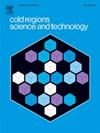结冰参数的现场测量及其在冰荷载图中的应用:综述
IF 3.8
2区 工程技术
Q1 ENGINEERING, CIVIL
引用次数: 0
摘要
冰荷载图用于规划和设计易结冰地区的基础设施。它们是根据长期数值天气预报模式模拟的微物理输出得到的。在这种模拟中使用的一个常见微物理方案是汤普森“气溶胶感知”参数化方案,该方案在天气研究预报(WRF)模式中实现。冰荷载图的生成依赖于关于结冰参数的几个关键假设,主要是利用来自WRF的云滴数浓度(CDNC)和液态水含量(LWC)的伽马分布可以准确计算中位体积直径(MVD)。由于难以在现场测量这些参数,这一假设的验证受到阻碍。最近的技术进步使这些测量成为可能。进行了这样的测量活动,并在模拟冰荷载图计算方案的分析方案中执行了其结果。测量结果表明,WRF中液滴浓度的假设值被高估了。分析计算结果表明,当提供适当的输入数据时,Thompson“气溶胶感知”方案中的广义伽玛分布足以表示结冰情况。WRF的结果被认为可以进一步用于冰荷载图的生成,然而,关于新观察到的CDNC、LWC和MVD之间的特征和联系如何影响结冰率,特别是在这些暴露的海上地点,现在存在一些悬而未决的问题。在更精细的时间分辨率尺度上重新评估实测结冰数据,并与WRF模型输出解耦,可能有必要改进所得结果。然而,需要对Thompson“气溶胶感知”方案的液滴激活参数化和/或背景CCN浓度进行修改,才能重现测量到的液滴分布特性。本文章由计算机程序翻译,如有差异,请以英文原文为准。
Field measurements of icing parameters and their application towards ice load maps: An overview
Ice load maps are used for the purposes of planning and design of infrastructure in ice-prone regions. They are obtained based on microphysical output from long-term numerical weather prediction model simulations. A common microphysics scheme used in such simulations is the Thompson “aerosol-aware” parameterization scheme implemented in the Weather Research Forecasting (WRF) model. The generation of ice load maps relies on a few key assumptions regarding icing parameters, primarily, that the Median Volume Diameter (MVD) can be accurately calculated using gamma distribution from the values of Cloud Droplet Number Concentrations (CDNC) and Liquid Water Content (LWC) from WRF. The validation of this assumption is hampered due to difficulties of measuring these parameters in field. Recent technological advancements allow for these measurements. Such a measurement campaign was carried out, and its results were implemented in an analytical scheme, mimicking that of an ice load map calculation scheme. The measurement results show that the assumed droplet concentration values are overestimated in WRF. The analytical calculations results show that the generalized gamma distributions in Thompson “aerosol-aware” scheme is adequate for representing icing conditions when supplied proper input data. The WRF results are deemed useful for further use in the generation of ice load maps, as-is, however, there are now open questions about how the newly observed characteristics and connections between CDNC, LWC and MVD can impact the icing rates in particular at such exposed maritime sites. A re-evaluation of the measured icing data on a finer time resolution scale and de-coupled from WRF model output may be warranted to improve the obtained results. However, modifications to the droplet activation parameterization of the Thompson “aerosol-aware” scheme and/or the background CCN concentrations would be required to reproduce the measured droplet distribution properties.
求助全文
通过发布文献求助,成功后即可免费获取论文全文。
去求助
来源期刊

Cold Regions Science and Technology
工程技术-地球科学综合
CiteScore
7.40
自引率
12.20%
发文量
209
审稿时长
4.9 months
期刊介绍:
Cold Regions Science and Technology is an international journal dealing with the science and technical problems of cold environments in both the polar regions and more temperate locations. It includes fundamental aspects of cryospheric sciences which have applications for cold regions problems as well as engineering topics which relate to the cryosphere.
Emphasis is given to applied science with broad coverage of the physical and mechanical aspects of ice (including glaciers and sea ice), snow and snow avalanches, ice-water systems, ice-bonded soils and permafrost.
Relevant aspects of Earth science, materials science, offshore and river ice engineering are also of primary interest. These include icing of ships and structures as well as trafficability in cold environments. Technological advances for cold regions in research, development, and engineering practice are relevant to the journal. Theoretical papers must include a detailed discussion of the potential application of the theory to address cold regions problems. The journal serves a wide range of specialists, providing a medium for interdisciplinary communication and a convenient source of reference.
 求助内容:
求助内容: 应助结果提醒方式:
应助结果提醒方式:


